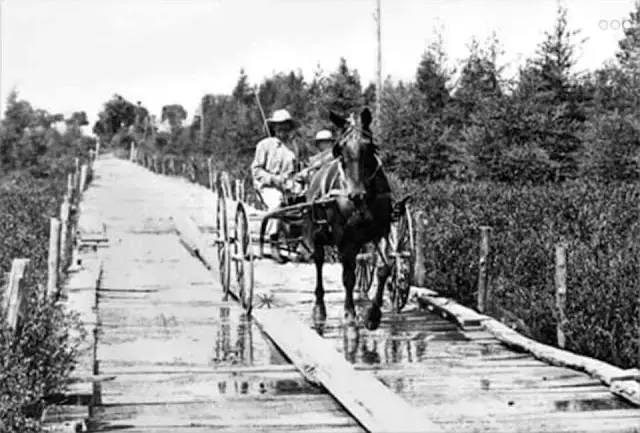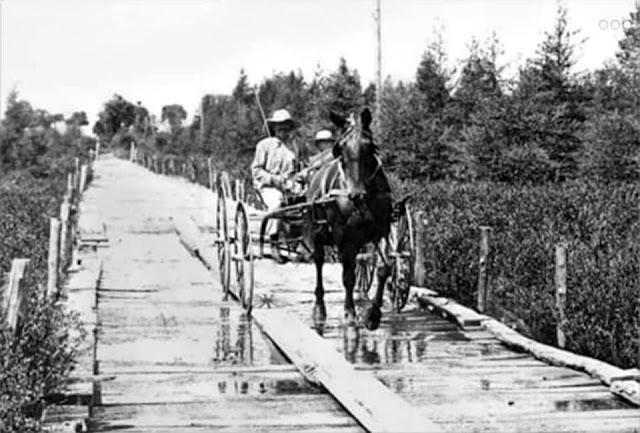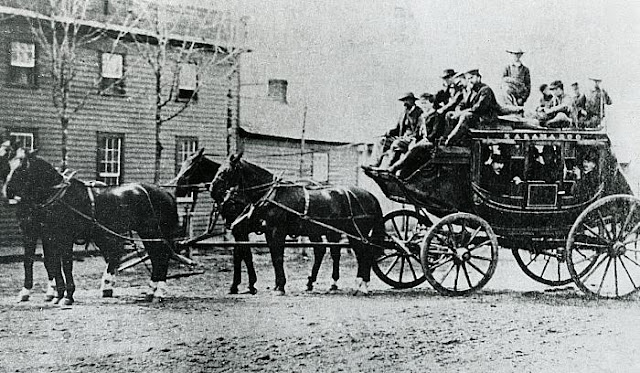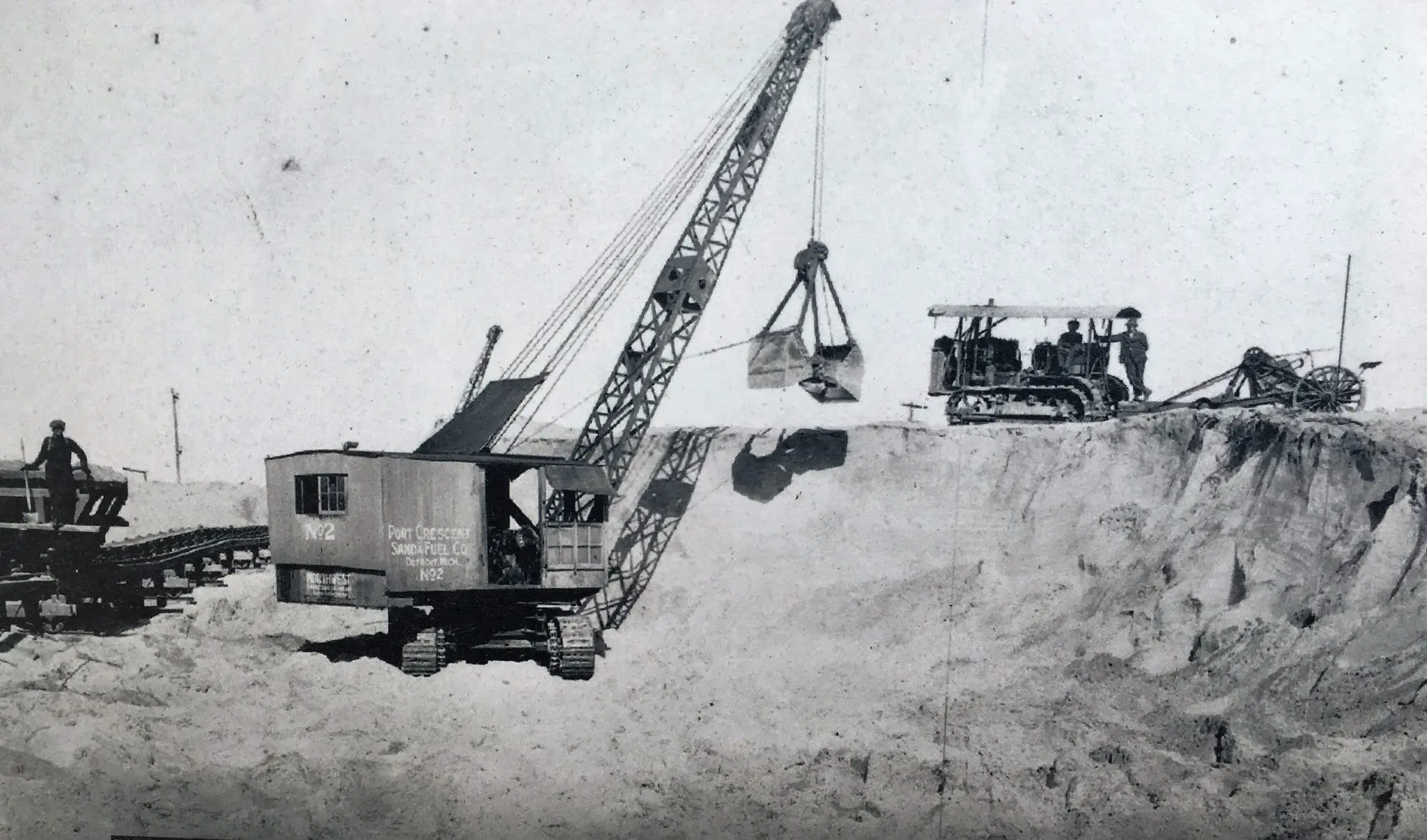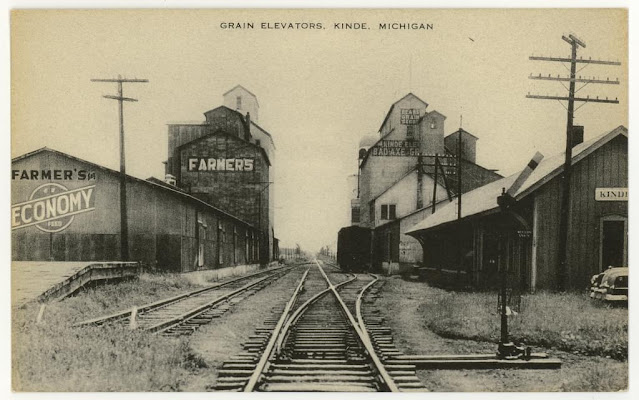Until the early to mid–1800s, many of our country’s highways were dirt and mud trails. A contemporary movement at the time advocated for constructing timber roads, which would be a significant advance in transportation. These plank boards were put across the road on log foundations in various lengths, but the majority were eight feet long. The roadways were built for wagons and were 12 feet or wider. These Michigan plank roads were broader in downtown areas.
The First Michigan Plank Roads
While the first plank road was constructed in New York, the first corporation chartered to build a plank road was formed in Michigan in 1837. The Detroit, Plymouth, and Ann Arbor Turnpike Corporation or Timber Road Company was chartered by the Michigan House of Representatives on March 20, 1837.
Over 200 plank road companies were founded in Michigan throughout the 1800s, with licenses granted for the building and operating approximately 5,800 miles of plank roads. Some were 220 miles long, from Zilwaukee to Mackinaw City via Traverse City. One was barely one mile long and was located in Sault Saint Marie, Michigan’s Upper Penninsula.
Michigan’s Hundreds of Miles of Indian Trails Made Today’s Highways Possible
The United States Government dispatched surveyors from the east to Michigan in 1812. Settlers were given their first opportunity to begin farming. The settlers’ desire for a place of opportunity drove them westward from Detroit across Michigan. They took the Indian trails. The settlers were warned that the area ahead of them was worthless swampland as they progressed. The settlers’ aspirations faded with time, yet they persisted. The ladies drove the teams while the men walked. The 80-mile trek took the settlers three weeks to get from Detroit to homestead locations in west Michigan.
In the middle of the nineteenth century, the Grand River trail was enlarged into a plank road, which served as the foundation for one of the first state trunkline roads, M-16, in the early twentieth century. Later, M-126 was replaced by M-104, and the roadway was realigned.
Ann Arbor Turnpike Corporation
The Detroit, Plymouth, and Ann Arbor Turnpike Corporation were among the first to be chartered. It was chartered (with an extraordinary sum of $100,000 in its day) to create a “wooden road built of excellent, well-hewn timber” from Detroit in Wayne County to Ann Arbor in Washtenaw County. Later, in 1844, the state approved the construction of plank roads between Detroit and Port Huron and close Sylvania, Ohio, and Blissfield, Michigan. The Corunna and Northampton and the Marshall and Union City Plank Road companies were granted charters in 1846.
Depending on the weather and topography, constructing a plank road ranged from several hundred dollars to several thousand dollars per mile. The construction process involved digging trenches on each side of the plank road to drain water and avoid mud from collecting under and over the boards as part of the upkeep. As a result, wagons filled with goods and agricultural products, as well as the animals hauling them, were not delayed or halted by mud and could enjoy a hazard-free trip once they reached a plank road. Planks were also used to build bridges. Even now, you can come upon a wooden bridge, comparable to an ancient plank bridge, on your travels.
Plank Roads Lasted Well Into the 1900s
Plank roads remained popular far into the twentieth century, when the first motorists, straining to navigate muddy roads and rough gravel roads in their Model Ts, were all too pleased to have a flat surface on which to travel. A great deal of pomp was typically associated with the inauguration of a plank road, just as it is now when a new section of roadway is finished. In July 1852, residents assembled in Lansing, Michigan, to commemorate the inauguration of the Lansing-Howell Plank Road. The stagecoach carrying the ceremony’s keynote speaker could be heard arriving from a mile away as it drove along the new plank road. The crowd began applauding as the stagecoach approached. Finally, they had a path on which they could rely.
The plank road, like many other inventions, was a forward-thinking concept that significantly improved local transport. After a few years, though, the planks began to twist and rot away. Repair costs, additional timber, gravel, toll structures, staff, and management all played a role. Stone was used for compensating for the planks’ deterioration, resulting in a slower and bumpier ride.
Plank Roads in Saginaw
Plank roads faded into obscurity, with several still lying dormant and forgotten beneath today’s concrete roadways. Then, in April 2010, a 159-year-old relic was discovered by Saginaw’s 19th-century city engineering staff. In terms of Saginaw history, it is “the pot of gold at the end of the rainbow.” Crews discovered another portion of one of the community’s original highways, a plank road that ran from Saginaw to Flint beginning in 1851, at the intersection of E. Genesee and Baum. In the 1800s, early Saginaw residents erected the double-decker stacks to counteract the region’s marshy environment. The empty space between the stacks allowed air to travel, making the highway more stable in the bayou-like environment.
The pioneers and early settlers were very proficient engineers. Highway workers uncovered the plank road fragments while working on a multi-million dollar East Genesee restoration project. Because of the nature of the terrain, this was not a simple one to create. One has to envision what it was like building the plank road along what is now Michigan’s part of Dixie Highway. Workers have to chop down and mill “thousands of trees” during construction.
The Rise and Fall Of Michigan Governor Epaphroditus Ransom Due to Michigan Plank Roads
Epaphroditus Ransom arrived in the Michigan Territory with his family on November 14, 1834, after a month of a journey by riverboat and stagecoach. He and his wife settled in Bronson, Michigan (the residents eventually changed the settlement’s name to Kalamazoo) and immediately applied for the bar. Ransom traveled extensively on horseback throughout western Michigan as a lawyer, practicing his profession and earning many political connections. He would go on to become Michigan’s 7th governor and Chief Justice of the Michigan Supreme Court. On January 3, 1848, he was inaugurated in Michigan’s brand new state capital in Lansing, Michigan.
Among his significant successes during his governorship was the development of privately maintained plank roadways. These linked rapidly developing cities such as Grand Rapids, Saginaw, Lansing, Kalamazoo, and Detroit.
Michigan Plank Roads Law Under Governor Ranson
In 1848, the Michigan State Legislature passed a comprehensive Plank Road Bill. Ranson quickly signed the bill into law. A legislative charter was no longer necessary to build and administer a plank road. According to the new regulation, any business may operate a plank road as long as it meets specific standards, such as being two to four rods wide, with 16 feet of it in a good, smooth, permanent road well-drained by ditches on either side. In addition, a minimum of eight feet of road was to be covered with three-inch-thick boards. The legislation also stipulated that no grade should be greater than one out of 10 and that business charters should be valid for 60 years.
Ransom and his son sold the family property and made significant investments in plank road firms following his time as governor. However, they lost everything after the Panic of 1855 and when plank roads gave way to the ever-expanding railways.
Mid Michigan Had Its Growth Due to Plank Roads
The original Grand River Avenue corridor walk was an Indian trail, a footpath utilized by the aboriginal inhabitants. The earliest European immigrants in the region used this path, which they widened in some places to allow carts to pass. Grand River Avenue in Detroit is one of five primary streets designed by Judge Augustus Woodward in 1805 that stretched from Center Detroit in different circumferential directions; (along with Woodward, Michigan, Gratiot, and Jefferson) Grand River Avenue stretches northwest from the city’s downtown.
Early Plank Roads Created Michigan’s Pre-Tourist Hotels and Inns
The first inns and hotels in Michigan catered to settlers and laborers rather than tourists. As people traveled west to experience what Michigan had to offer in terms of harbors, rivers, woods, and agriculture, modest inns were built in major population areas. These inns were generally situated along water transit routes or, following the introduction of stage travel, along the three principal trails that crossed southern Michigan in the early nineteenth century: the Chicago Road, the Territorial Road, and the Grand River Trail.
Due to the restricted distance that could be traveled by horse, wagon, or stage in a single day, it was common for inns to be placed close to one another. Between 1820 and 1840, these inns were often built with a wood structure. They were typically small, with a few sleeping chambers and a taproom with a big hearth where meals might be prepared and served.
A Michigan historical marker denotes one such inn. “Peter Seitz, a German immigrant, erected a home on the North Custer plank toll road in 1856 as a residence and stagecoach inn. Stagecoaches were formerly hauled by teams of up to four horses. The plank roads were constructed with wooden planks to facilitate driving during the “muddy season.”
The inn was a favorite meeting place for residents and stagecoach travelers alike. The package includes a hotel, dinner, drink, and entertainment. Dances and other social and community gatherings were held in the second-floor ballroom. Residents in this area began the planning that led to the building of St. Matthew’s Lutheran Church in 1860. These inns were widespread in the little towns and villages along the early plank highways.
The structure was utilized as an inn until it was converted into a single-family residence around the turn of the century.”
The Gratiot Plank Road Company
The Gratiot Plank Road Company was founded in 1868 by Ammi Wright and William Glasby, with Wright serving as president and Glasby as a contractor. The Michigan state government has hired them to construct a 32-mile-long plank road made of excellent, well-hewn timber three inches thick to connect Saginaw and St. Louis. Farmers, merchants, and a stagecoach line traveled daily on the route that ultimately became M-46 between Saginaw and St. Louis by 1870.
A photograph of the plank road was found in the Saginaw Public Library archives dated 1860. This is Genesee Street, according to the sign. It appears to be from an old western movie set rather than a tiny hamlet in Michigan. Norman Little created the first plank road from Saginaw to Flint, paving the way for Saginaw’s prosperity.
Plank Roads and the Birth of Motor Vehicle Travel
Stage lines traversed terrain that was frequently made up of plank roads, making stage riding extremely rough. The roadbed was likewise alternately dusty and muddy. By 1904, Tuscola County had just a few stage lines left, and they traveled to locations where there were no railroad connections. The speed and comfort of the train finally put an end to the stagecoach industry. Railroads were faster, and their fares were less expensive.
Grand River Avenue Opens, First Paved Road Across State
Fast forward 70 years to 1926, when US Highway 16 was one of the main routes in Michigan before the post-World War II development of freeways. Before establishing the United States Numbered Roadway System in 1926, the highway was classified as a state highway with the designation M-16.
Grand River Avenue’s current course runs northwest-southeast across the Lower Peninsula, from Grand Rapids to Detroit. Between 1955 and 1965, US-16 used other routes between Muskegon and Grand Rapids, then Grand River Avenue via Lansing to Detroit. US 16 was converted from older roads to modern highways in the years preceding the formation of the Interstate Highway System. It was later classified as an Interstate. When the highway gap near Lansing was closed up, the state’s US 16 designation was discontinued. East of Grand Rapids, the highway was only known as Interstate 96 (I-96), and west of the city, it was known as Interstate 196 (I-196).
Sources
https://en.wikipedia.org/wiki/Plank_Road_Boom
https://www.fhwa.dot.gov/infrastructure/back0508.cfm
https://www.michigan.gov/documents/mdot/RR668ADMIN_8_539527_7.pdf
https://villageofwebberville.com/our-history/
https://www.kpl.gov/local-history/kalamazoo-history/transportation/plank-roads/
